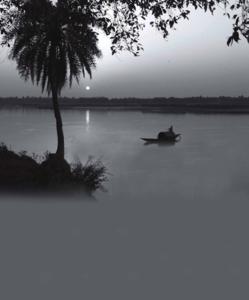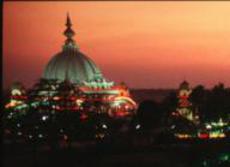Capturing the essence of Mayapur by the ears

I am constantly aware of the sound track that is my life a life truly defined by sound. There is no getting away from it: there are always the sounds that intrude, but there is also a symphony of sound that surrounds me on a daily basis soft, beautiful, sounds that enliven the spirit, touch the soul, ease the mind, and satisfy a hundred other platitudes. It is a philosophy of sound that I aspire to perfect: that the spiritual sound vibration raises one’s consciousness above the mundane, and that, through sound, one can and does achieve spiritual perfection. In short, the power of the mantra beats the sounds of life hands down.
So I won’t focus on the marble polisher whose whining machine is piercing my brain as I write. His whine cannot spoil for me the reassuring, heart-tugging (for some reason) sound of the river boat as it crosses to our side of the Ganges from Navadvipa. That boat sound is often the last sound I hear at night, as the final boat for the day plies through the dark waters and pours out the few remaining straggler-passengers to the bank they call their home.
I love the sound of the düdh-wallah arriving on his bicycle, twin barrels tied across the back of his bike, hanging down one against each rear tire guard. They are full of milk, and across the top is a pile of straw to contain the splashes. The sound of his barrels knocking the post he leans his bike, or the sound of his pitcher dipping into the barrels to scoop out the milk, or the sound of milk cans knocking on the ground as he fills them for his customers these sounds reassure me of the timelessness of some rituals that can never be replaced by modernity. Some things will never change, and sometimes that’s a wonderful, wonderful thing.
The sound of villagers calling to each other replicates that timeless, assured feeling that all is well. In Bengali, “O!” means “Hey!” so their calls to each other, which carry across the gardens and down the paths, sound like an ancient call of the royal order, preceded with what in English is a term of utmost respect and veneration (as in “O Lord!”). Their shouts to friends, to our ears, take on a dramatic slant that is absent in our own dealings, “O Lokon!!” “O Nivas!” They sound like cries from another era, when they are only friendly shouts. . . .
I love the sound of someone spontaneously breaking into a song of praise, heartfelt love, a lament at separation from their beloved, an idle humming of a tune remembered from morning, a sound that carries across the field from a temple behind my house, from the mali(gardener) down in my garden, from a rickshaw-wallah gliding by, sans passenger…
The temple bells strike my heart and enter deeply into my sub conscious mind…their timing always the same: morning arati, midday arati, evening arati…a cyclic security blanket that drapes the aching mind in thoughts of eternal roots, and helps it meander inevitably away from the intrusions of life.
 The long, slow cry of the conch, blown in every temple in the area to announce the beginning of something or the end of something, is a constant reminder to me to begin something, to stop doing what I’m doing and get to the important stuff . . . a plaintive cry from another world, and another reassurance that I’m in the right place . . .
The long, slow cry of the conch, blown in every temple in the area to announce the beginning of something or the end of something, is a constant reminder to me to begin something, to stop doing what I’m doing and get to the important stuff . . . a plaintive cry from another world, and another reassurance that I’m in the right place . . .
But it is the indolent yet reliable dong, dong, of the bell at the gate of the nearby temple that is my guiding sound as it announces itself all through the day and night. Twenty-four hours, the temple guards rise on the hour and perform their duty. Sometimes raucous and sharp tolls on a loud and colorful festival day; sometimes solemn and slow, in the small hours of a misty, dark, and long night: a solo dongggg that resounds across the village.
And all is well. Welcome to Mayapur. . . .
Braja SevakiDeviDasi, a disciple of His Holiness Tamala Krsna Goswami, joined ISKCON in Australia. She has lived in Mayapur for nine years with her husband, Jahnudvipa Dasa. Together they published Mayapur Journal and Mayapur Magazine for several years. She is also the author of "Eighteen Days: Sri Panca-tattva's Mayapur-lila," and a soon-to-be-published book, "Lost & Found in India." – (Photos by Kaivalya Sundari Devi Dasi)
